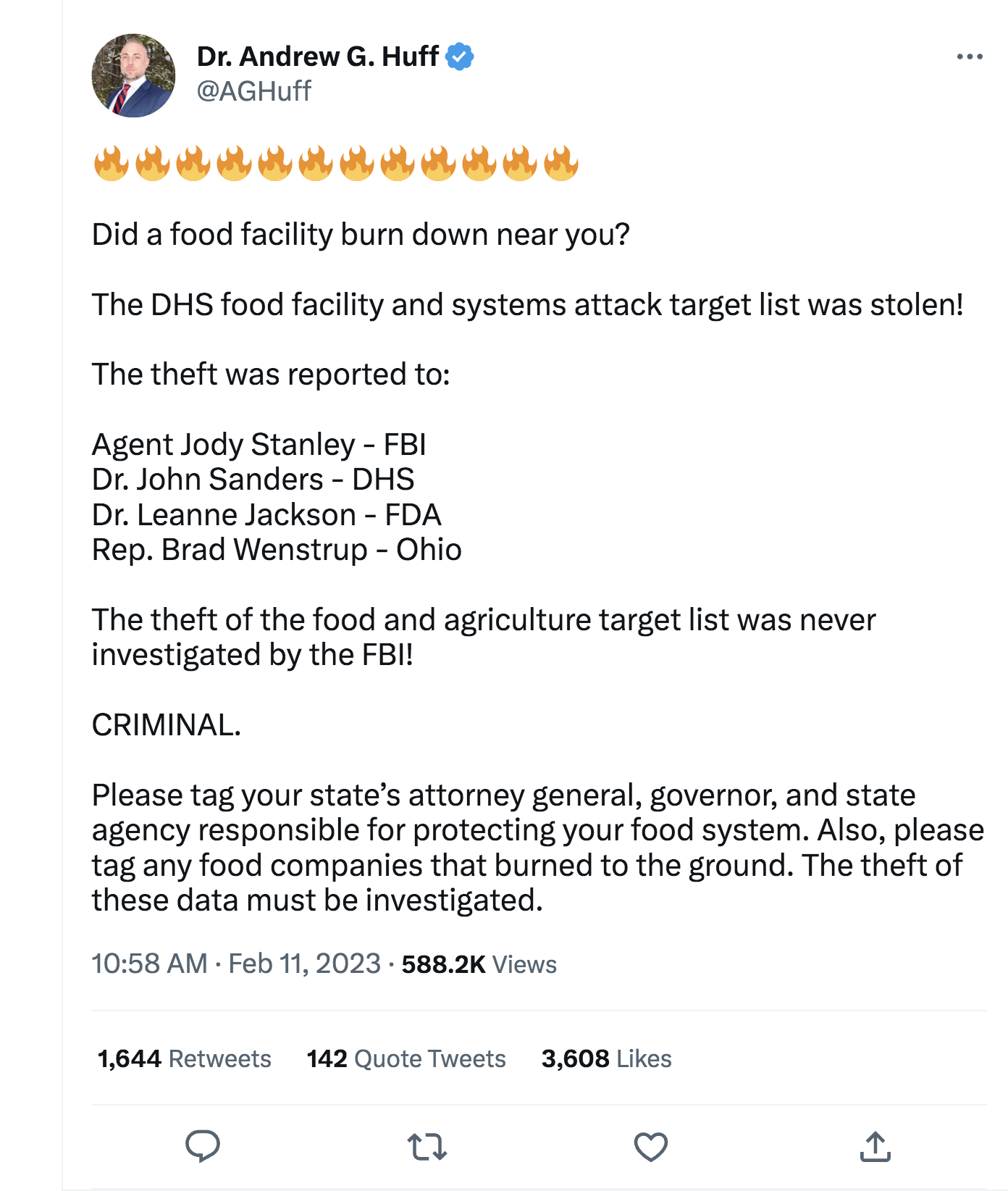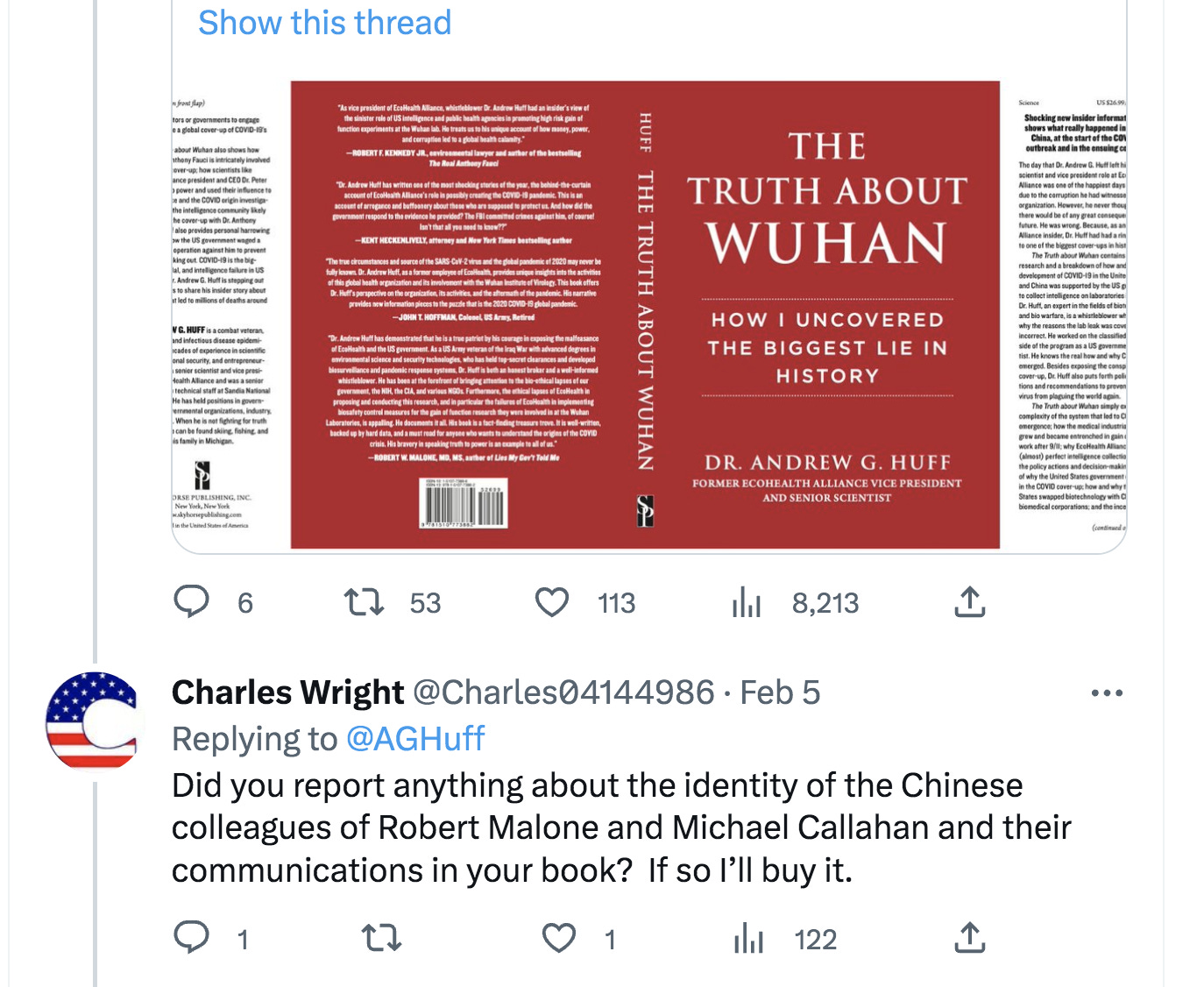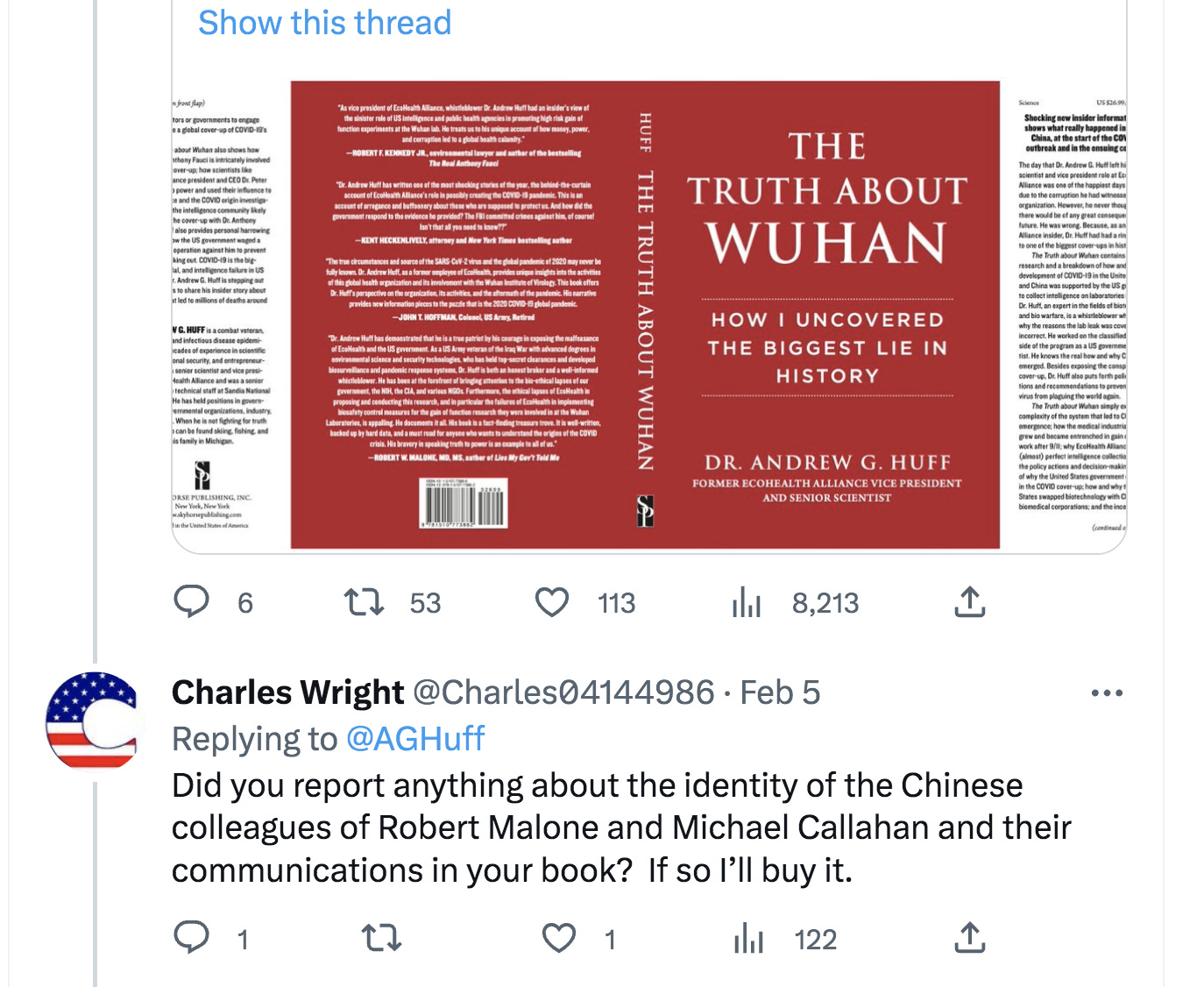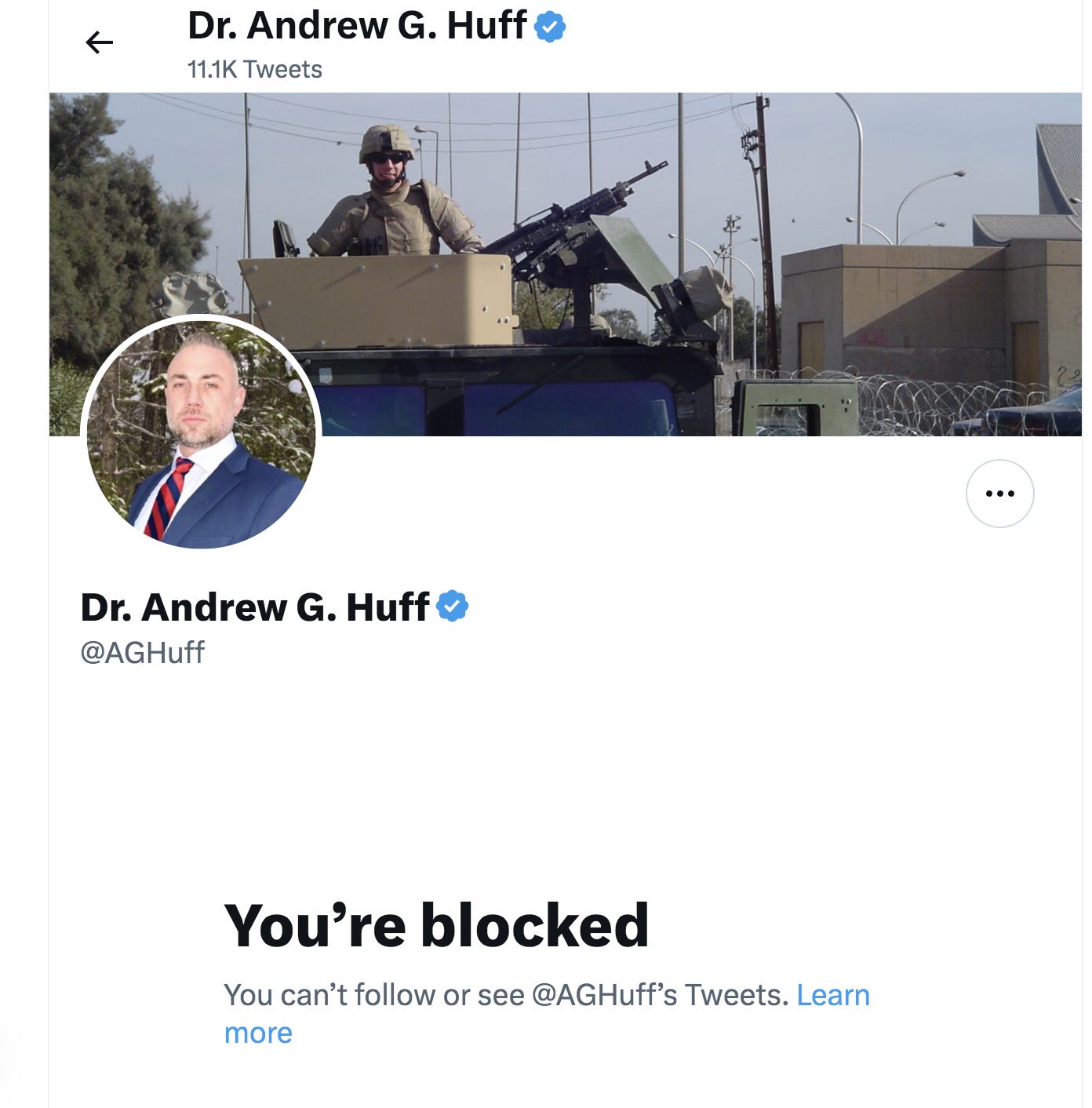Former EcoHealth Vice President Andrew Huff says his "attack list" of US food facilities went missing from his personal computer and is being implemented
(By who or what?)
Andrew Huff is a self-described “whistleblower” who joined EcoHealth in 2014 and left in 2021. You may know him as an author of “The Truth About Wuhan,” one of several books on the Wuhan Institute of Virology and COVID-19.
Huff appeared on the MG Show February 9 to discuss his claims that his “attack list” had disappeared from his personal computer, and that those same places had fallen under attack. He described his background in the military, academia and intelligence:
I’m not your typical infectious disease doctor or academic. I started my career in the US Army as an Infantryman. I was combat deployed during Operation Iraqi Freedom. Degrees are in Psychology, Security Technology Engineering, Geographic Information Systems. My PhD is in environmental health with an infectious disease specialty track, which is public health epidemiology essentially. I did some post-doc work at MIT in complex systems. I was a scientist at Sandia National Laboratories where I was a senior member of the technical staff where I worked on Pandemic preparedness plans, complex models and simulations of disasters and doom and gloom, trying to figure out how we respond to national security threats. My area of expertise was bioterrorism and biowarfare, pandemics and emerging diseases. I got sick of working in the classified space and I went on to work at EcoHealth Alliance.
Somewhere along the way, (I didn’t catch they dates if he said them), Huff created an “attack list” of US food facilities.
I had a highly sensitive national security data set, which I constructed. So I wrote the book on how to attack US food facilities. I was a research fellow at a Department of Homeland Security Center for Excellence on PhD full scholarship. And I started working with the 3-letter agencies on trying to figure out how to protect the American food supply. Well I essentially wrote the book on it. I published all the papers. And I developed the classified attack methods and models which are sitting in the government somewhere. But anyways I had this work, because I began it as a PhD student. I actually had the attack list on my personal drives. And guess what. It went missing.
Not only did Huff’s attack list go missing from his personal computer, he says that these facilities fell under attack.
Look what’s been happening with all of these food facilities attacks over the past year. And here’s the craziest, and I was tweeting about this today (Feb 9, 2023), so I analyzed the attack facilities versus that target list, and it’s almost a perfect match. The probability of that happening- zero.
Huff went into some greater detail about the origin of the food facility attack list.
The way that this worked was that a couple of other research scientists, military experts, and myself, they went around the country collecting the data from states and industries. So they would have meetings and sent the experts down to people who owned all the food in the United States - it was a massive project. And then they’d have them walk them through was called - it’s called a modified delta method if you want to get nerdy. But what that means is they’re using subject matter experts to collect all the different risk, threat, vulnerability, and attack data, including methods of attack on the system. So, for example, they would go to someone in the chicken production industry, broilers you’d buy in the grocery store, and they’d say, hypothetically speaking, if someone was to attack your food system or your facility, what would be the most catastrophic thing that could happen? And they’d tell you. You know like burn it down, you destroy it, you poison the chickens, you use a zoonotic disease, you use a chemical agent, and there’s a whole list of different things you could use. And then you’d ask well what’s the magnitude of this impact, and what kind of impact would it have on the country? So all that data- gone. So it’s basically a roadmap of how to attack US food facilities and systems.
Huff said that he reported the missing food facility attack list to several government agencies, including the FBI, DHS, FDA, and Representative Brad Wenstrup (Ohio) of the House Intelligence Committee.
I recently had a brief discussion with Huff on Twitter before he blocked me. On Feb 5, I told him I would buy a copy of his book if he said anything about Michael Callahan and his Chinese colleagues.
The role of Michael Callahan in China, a self-described bioterrorism expert who testified to Congress that was deeply involved with biowarfare scientists in the former Soviet Union, and was routinely called by said scientists when they had lab leaks, is one of the many “elephants in the room” that the media refuses to discuss.
I was trying to keep an open mind on Huff as a “whistleblower” at this point. EcoHealth Alliance is one of the most evil organizations in the history of mankind. The primary purpose of EcoHealth Alliance was to collect, modify, and transfer viruses from one bat species to another all over the world to simulate a natural evolution of pathogenic viruses that would later “spill over” and could be blamed on nature. Maybe he didn’t know that, but when he said that “The Callahan story is false” and that “He was not sneaking into Chinese hospitals” because Callahan was “white,” I thought that was either extremely stupid or deceptive. So I reminded him that one of EcoHealth Alliance’s own white guys, Ian Lipkin, actually set up China’s version of a CDC after SARS1. (1). As a former VP of EcoHealth, and a “PhD … in environmental health with an infectious disease specialty track,” I think Huff should know about the history of white guy Ian Lipkin and China, and I don’t like the way he dismissed Callahan’s reported presence in Wuhan Central Hospital without any reason other than his race.
Maybe I pissed him off on Feb 5, but he didn’t block me at this point. He blocked me after I made a few comments about the methods by which fires at food facilities might be set.
I’ve been thinking about the wicked applications of directed-energy weapons for many years. Starting fires is just one of these applications. Every fire season in the US, which seem to keep getting worse, I always think about these weapons. On this day, Feb 12, at 2:42 PM, it just so happened that the United States shot down another “unidentified object” at 20,000 feet over Lake Huron, Michigan. This object had no visible propulsion system. I figure it was powered by electromagnetism or something similar. It also crossed my mind that it could possibly have been a directed-energy weapon. I don’t know but how can we rule that out without an explanation?
Huff first replied that he thought the fires were started by “arson or cyber attack.” Then he blocked my on Twitter. I’m not saying it’s related.
Around this time on February 12, a Twitter narrative “why are we talking about UFO’s when we should be talking about the environmental disaster in Ohio?” really picked up.
And while I certainly concur that the environmental disaster is a huge concern that should be discussed and reported, I hardly think that unidentified objects over your head are a distraction. I can consider two things in the course of a day myself. I didn’t tell anyone not to talk about Ohio. Directed energy weapons can start fires, they can warp train tracks, they can make people drop dead without a trace. I’m not saying that’s been happening, but it could be happening.
Congress needs to demand answers on exactly what the objects shot down were and what their propulsion systems were.
Charles Wright
(1). Columbia.edu, China Honors Ian Lipkin, January 07, 2020.
At the height of the SARS outbreak in 2003, Lipkin was invited by senior Chinese scientists and officials to assess the state of the epidemic, identify gaps in science, and develop a strategy for containing the virus and curtailing infections and deaths. Once the outbreak was contained, Lipkin helped develop the institutional infrastructure to ensure China would have the resources to detect and more rapidly respond to emerging infectious threats, in part through building the Institut Pasteur in Shanghai, new national Centers for Disease Control in Beijing, and the Guangzhou Institute of Biomedicine and Health. Today, he continues to consult with the Ministry of Science and Technology, the Chinese Academy of Science, and the Ministry of Health. He has also served as a consultant for a climate change program at Beijing Normal and as a visiting professor at Beijing University. Last year, the Chinese Academy of Sciences awarded funding for a collaborative project between CII and Sun Yat-Sen University in zoonotic diseases. Since 2003, Lipkin has presented more than 20 lectures in China, notably including the inaugurations of the Institut Pasteur de Shanghai in 2004 and the Beijing Center for Infectious Diseases two years later. In 2016, he was honored with the China International Science and Technology Cooperation Award, presented in the Great Hall of the People in Beijing, presided by President Xi Jinping.












Mr Huff claimed the last good thing the government did was the 9-11 commission. Uh Ok sport. 'Nuf said.
During the time that Trump was moving to limit trade with Chin. in preference of US industries, the West Coast forests had unprecedented wildfires, and satellite imagery from space captured laser light lines aimed at the combustion sites. This also coincided with the timing of dems. trying to start an impeachment process, so the destruction of our ancient forests could have been a US-driven warning aimed at undermining his efforts or an outside source -- either way these trees are sacred and must be entirely off limits to human evil pettiness. This was before the Hong Kong protests were stirred up by western media and Covid was launched. I will paste in the link to people tracking that when I come across it again.